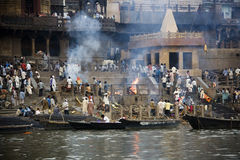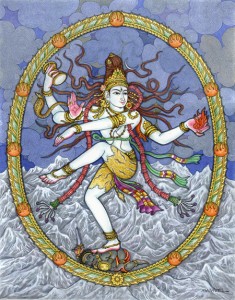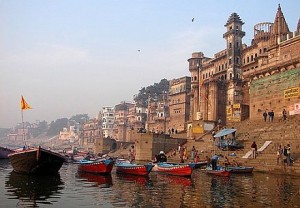Introduction
Varanasi! How can I describe your beauty and your madness, your noble aspirations and your often chaotic reality? Oh city of Shiva, you remind me of life’s highest goal, and the futility of chasing worldly desires. You contain terrible poverty, but you posses the wealth of thousands of years of crystalized spiritual knowledge. You are the victim of global capitalism’s inhumanity, but you testify to the transcendent God that is called by many names and who alone exists. You are filled with modern pollution, but the fragrance of your devotion to God has blessed the world many times over.
I recently went on an amazing one-month pilgrimage to India, and stayed in the two holy pilgrimage cities of Varanasi and Bodhgaya. I stayed in Varanasi for 9 days. Varanasi is one of the oldest continuously inhabited cities in the world, is considered the holiest pilgrimage site for most Hindus, and is highly influential to Buddhists as well. The Buddha gave his first sermon just outside Varanasi in Sarnath nearly 2500 years ago. Shankara, a great sage who influenced nearly all subsequent branches of yogic thought, is believed to have once lived here. Tulsidass, Lahiri Mahasaya, Trailingaswami and countless other Yogi-Christ’s have blessed this city with their presence over the centuries.
If you want a history of Varanasi, this is not your post. Rather, I will write a few poetic descriptions of my experiences there, and intersperse my thoughts with spiritual musings. This post will mainly focus on Varanasi’s famous funeral Ghats and my thoughts on God-Realization, the goal of life. At the end of the day, what am I but a hopeless poet in the guise of a philosopher? Yet may I always be a poet and never merely a philosopher! Philosophers explain; poets create. Philosophers debate; poets wink. Philosophers describe God; poets enjoy Him.
The Cremation Ghats
 – Funeral Ghats in Varanasi
– Funeral Ghats in Varanasi
Walking through a mysterious warm evening on the stone-stepped platforms leading with regal grace to the sacred river Ganges, I smelled something strange and realized that I had arrived at one of the city’s several burning Ghats, where nearly 100 people per day are publicly cremated before their ashes are ritualistically scattered in the Ganges river. Many Hindus believe that they will attain salvation if they die in Varanasi and have their ashes placed in the Ganges.
This is the primary reason why a round-the-clock team of workers is needed to perform the funerals year-round, a ritual that has been continuously occurring for thousands of years. Many funerals take hours, and cryptic mantras are recited as the bodies burn on a pyre only twenty feet or so away from the public sidewalk. To my knowledge, mostly “untouchables” do the work of cremation, an unfortunate remnant of the caste system that I will reserve commenting on for another post. The public health issue of placing dead bodies in the Ganges – water which is used for teeth brushing, bathing, and cooking – is also obviously problematic, but I won’t discuss this here.
While walking at night down a silent river in a city of millions where no one knows my personal history or the short-lived success of my second grade piano recital, many thoughts occurred to me in an attempt to understand my immense past. How did my life lead me to this strange city and this lonely walk? What was the meaning of all my various experiences and struggles? What kind of man have I been, and who do I want to become? The part of my mind I call, “The Grader” was active: For this goodness, I get an A. For that error, an F. For that, a C. Oh, how endless and futile is the illusory ego’s attempt to categorize and justify itself!
And then, stopping my thought stream like the sudden sound of loudly shattering glass, I saw the fire and the body it was slowly decomposing. Silent and haunting, the scene spoke for itself. A human life just like mine – with all its ups and downs, with all its wishes and disappointments, with all its complex hopes and its cherished memories– lay engulfed in the impersonal flame of time, reduced to mute ashes. Only God knows how many countless millions of people have been similarly cremated on this very riverbank, a constant reminder of life’s impermanence, but also of its highest goal.
The raw power of the scene is unforgettable. It forces you to realize that everything you do will inevitably be forgotten by the world, and that everyone you love will eventually be taken from you by death. Yet, paradoxically, instead of solely being a symbol of death, the scene is also symbolic of life’s highest meaning. The body and all its desires will inevitably pass away, but the Eternal Self that is our True Self never dies. The fire is symbolic of the body’s inescapable death, but also of the Life of Shiva – our own True Nature – that temporarily enjoys but simultaneously transcends the physical universe.
Those who see the fires of Varanasi’s funeral ghats are reminded that our body is merely our “tent,” an impermanent vessel that it is unwise to get too attached to. As it says in the Bhagavad Gita (what many people call the Bible of India), just as we put on new cloths each day, so the Self continuously discards old bodies and acquires new ones. Those who see themselves as only the body grieve when death comes. But those who understand their Eternal Identity do not grieve for the loss of what is only their temporary garment. As Krishna controversially says in the Gita, “The wise grieve neither for the living nor the dead.” From the Absolute perspective, the wise see only God-Consciousness – how could they grieve?
Our True Identity
The enlightened know that our real identity is Spirit. Imperishable and changeless, It does not die when the body dies. To experientially realize this truth through meditation is the goal of human life, for nothing else can produce even a fraction of God-Realization’s indescribable Joy. To “see” God means to see that He is pretending to be everything, and from this perspective there is literally no death, only pretend forms of death, like characters dying in a movie or in a dream. Realization, as Ramakrishna says, is like thinking there is a deadly snake in your darkened bedroom. Then you turn the light on and realize that it is merely a rope! For, as Ramakrishna says, God does not merely create the universe – “He has become the universe,” but is not actually affected by its perpetual changes.
To actually realize this through meditation is the source of happiness itself, for God IS everlasting happiness, though this happiness is of a different category than how we typically define “happiness.” When we realize that all conditioned things – including the body – are impermanent, we no longer seek lasting fulfillment in what is doomed to pass away. When we finally realize that nothing apart from God-Realization can give us lasting happiness, we begin looking to God as the source of our fulfillment. From this perspective, the funeral pyre is not merely a symbol of destruction, but of mental purification. It puts things into perspective. It reminds us of impermanence, but also reminds us that Permanent Joy can be found in the realization of Shiva.
Yet one, of course, does not need to physically die to realize God. The folk belief that one must die in Varanasi to attain salvation is, in my opinion, an unfortunate mischaracterization of the spiritual path which takes many years, or perhaps even lifetimes, of dedicated effort in meditation to be consummated. The body is the expression of, and not a hindrance to, our God-Nature. The sages tell us that this very life is the manifestation of God! Through effort and the grace of the Cosmic Beloved, we can all realize Him in this very body. Yet while we don’t need to die to see God, we must “die” to our ego in meditation to see Him. As God told Moses in the Bible: “No man can see me and live.” For it is not as if “we” realize God or “gain” Him. In truth, God realizes God, and no ego remains. Ego is perceived as an illusion, though even this illusion is itself God’s manifestation.
Those who realize God through meditation are happy in both life and in death, for they experientially realize that they are not the body but are inseparably one with the Eternal Spirit. In the world, they enjoy God’s dream-drama in the form of the world, and play their part in the play of life with great zeal. And when they must give up their body, they suffer no loss or grief, for they viewed their life as only an interesting and temporary dream whose various events have no ultimate effect on the Dreamer, the sole Source of lasting Peace.
Shiva – God of Destruction, God of Eternal Life
 – Shiva in the form of Cosmic Dancer
– Shiva in the form of Cosmic Dancer
Part of the source of our constant mental suffering in the West is a misunderstanding about the nature of things, a refusal to accept that death/destruction is a natural part of God’s dream-drama. In the West, we often myopically think of God in His aspect of Creator. In Hinduism, there is a subtler and, I believe, more symbolically accurate view of God. The Hindu Trinity (very simplistically explained) contains Brahma the Creator, Vishnu the Preserver, and Shiva the Destroyer. It is assumed by most Hindus that God is One but has infinite aspects.
Shiva is, perhaps, the most misunderstood Hindu aspect of God. He is the God of destruction and the king of Yogis. He lives in the Himalayas, symbolic of the transcendent part of ourselves that changelessly abides in Eternity. He sits in the traditional yogic posture and is covered with ashes. Sometimes he is portrayed as Nataraja, “The Cosmic Dancer,” who morphs Himself into the kaleidoscopic transformations of countless eons. There are many other fascinating symbolic aspects of Shiva I wont discuss here. Varanasi is known as the City of Shiva, and it is believed by many that Shiva Himself dwells there. Pictures of Shiva, and temples to Shiva, are virtually omnipresent there.
Shiva, as uncreated Energy, is the natural destroyer of matter, for it is a common fact that anything created inevitably must be destroyed (or change forms). Yet Shiva is also the Bliss of Eternity that transcends, and also temporarily manifests, the material universe. If we falsely think that the material universe is all that exists, Shiva is the yogic insight that purifies us from this delusion. In this sense, Shiva is a “destroyer” of the ignorance of separation. He is not a dark force that merely destroys everything we love, but in fact Bliss Itself, and all things are His manifestation. Om Namah Shivaya!
What ignorance does Shiva destroy? For one thing, He destroys the false idea that happiness can be found in anything apart from God-Realization, and the illusion that we are identical with the ego and body. Shiva destroys our false hopes, but also offers an invitation to the Eternal Bliss enjoyed by Christ, Krishna, the Buddha, and all illumined sages. As the king of yogis, he also reminds us that God-Consciousness cannot be attained without dedicated spiritual practice.
In the burning Ghats of Varanasi, Shiva reveals His aspect of physical destruction, and offers a choice. Will we seek happiness is things that inevitably perish in this fire, or will we wisely seek happiness in the Imperishable, and realize a Bliss that cannot be taken from us, even by death? Christ similarly summoned humanity to choose their spiritual allegiance when he uttered, “You cannot serve God and Mammon (materialism is perhaps the best word for this),” implying that our selfish desires must be totally surrendered in order to realize God.
The choice, however, is experientially misleading, for do the wise not see that this very world is the manifestation of God Itself? When one finally experiences God-Realization, they can abide in the double blessing promised in both the Bible (Matthew 6:33-34) and in the Bhagavad Gita. They enjoy and fearlessly participate in the dream of life through the vehicle of the body. But their True Body, Formless and Imperishable, and inclusive of all things, is their sole source of happiness. In the play of human life, they no longer see life and death, arising and passing, good and bad. In truth, they see only one thing: Shiva, Shiva Shiva!
Conclusion – A Secret Hope
When a person without Self-Realization sees the burning Ghats of Varanasi, they may grieve about the inevitable demise of themselves and of all their loved ones. But someone with the Eye of Wisdom perceives within the Ghats the Cosmic Wink of Eternity, the perspective which realizes that what we call “death” does not affect our True Self. In truth, our own God-Nature exists forever, and we are never separate from It. God, in His Infinite Indescribability, has no name, but an appropriate temporary title could simply be, “Wow!”
The realization that God alone exists, however, does not negate the relative perspective. It is still appropriate to feel grief when loved ones pass, feel genuine compassion for the sorrows of humanity, and not ignore the tragedies people experience in our world. We also all must strive to help the world with our gifts, talents, and life energy. The Absolute perspective does not negate the relative law of selfless service that all are obligated to on Earth, a humbling truth all genuine sages and prophets continually remind us of. To lose the relative perspective would be to become inhuman. Yet the wise know that that Realization and Compassion are the same thing. For how does a sage express the wondrous realization that God is all things? By compassion, and compassion alone.
Through practicing meditation, devotion, and all the many paths that lead to the realization of God, all human beings have the capacity to realize God in this very body. And those who seek this Enlightenment first in their heart are blessed beyond all conceivable blessings! Despite the sufferings of the world, they have a secret hope that cannot be taken from them. In a strange way, the burning Ghats of Varanasi are a dark version of the cliché “glass half full or glass half empty” question. When they see the fire of Varanasi’s round-the-clock funeral pyres, the worldly see only the tragic death of the body, and the end of everything they hoped for. The wise look at the same fire but perceive the Bliss of Shiva, inexpressibly radiant and seeing out of their very own eyes.
May all beings be led through “expedient means” to the realization of God, which can never be described and is Bliss Itself. Thanks for reading! With love,
Jeffrey
Similar Posts:
- A Few Thoughts on Spiritual Peace
- Peaceful Protest: Wisdom from the Bhagavad Gita on Helping the World from a Spiritual Perspective
- Exploring the 4 Noble Truths Part 1: Life is Suffering
- Introduction
- Merry Christmas from Bodhgaya!
- Lessons from the Gita 2 – Three Dimensions of Renunciation
- Zen Meditation in Activity
- Perspectives on Forgivness
